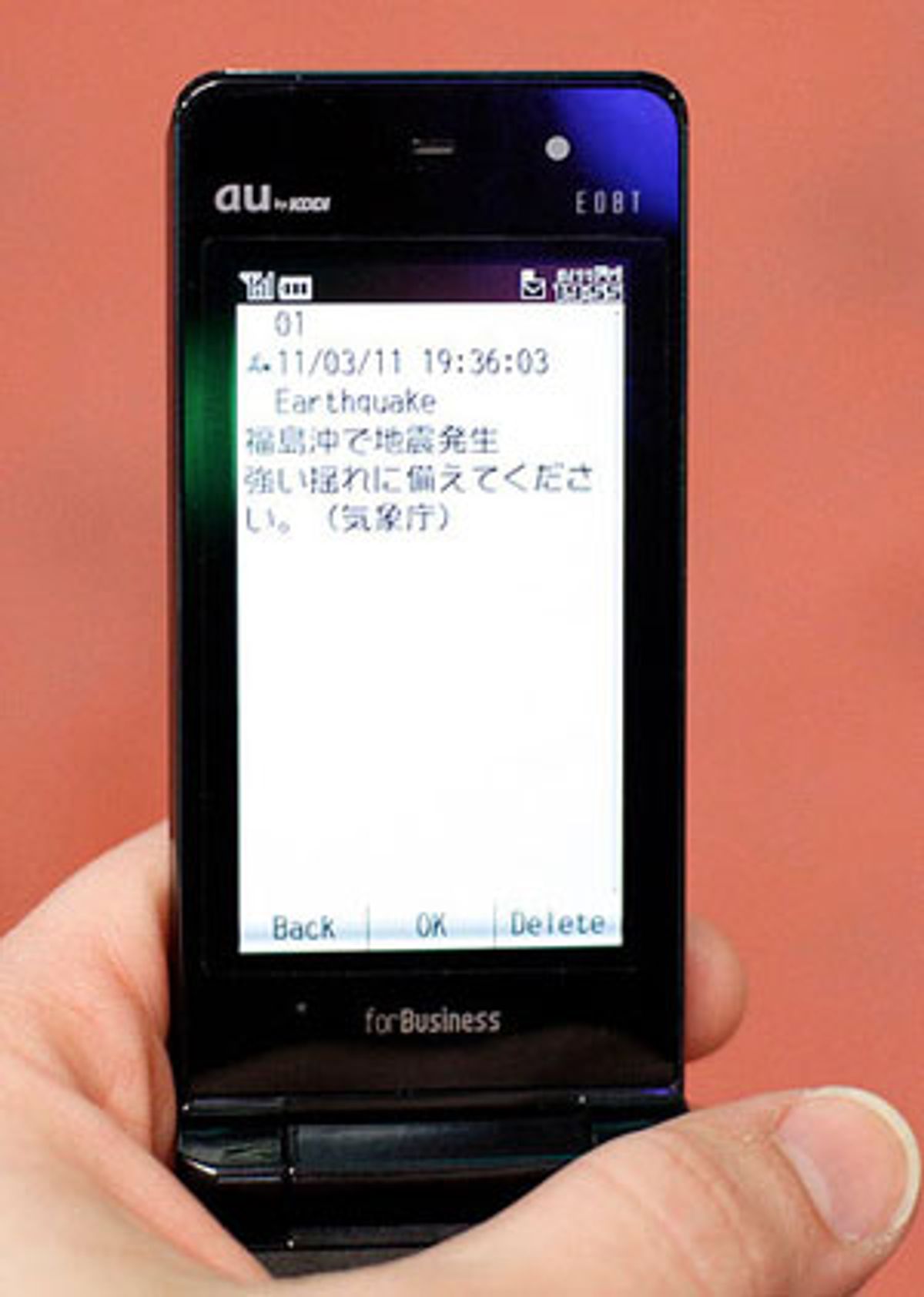Last week's devastating 9.0-magnitude earthquake off the coast of northeastern Japan highlighted both the advantages and the limitations of earthquake early warnings. Four years ago, Japan rolled out the world's most sophisticated earthquake early-warning system. The EEW system can detect the approximate source and magnitude of an earthquake and send out public alerts via TV, radio, and cellphone--all in less than a minute of a quake's start. It also transmits signals that can automatically shut down computers, stop elevators at the nearest floor, and halt factory production lines. [In the photo, an early-warning text message reads: "An earthquake at Fukushima-oki has begun. Please be prepared for strong tremors. (Japan Meteorological Agency)".]
The EEW system, which is operated by the Japan Meteorological Agency, relies on a network of about 1000 seismic stations scattered around the country. It exploits the fact that an earthquake generates different kinds of energy that radiate out from the epicenter at different speeds. Here's how I described it in a June 2007 article when the early warning system was just about to come online:
Nondestructive P waves (P for primary) propagate out from a ground rupture at about 6 or 7 kilometers per second, while the much stronger S (secondary) waves that cause most of the damage travel only at about 3 or 4 km/s. The farther you are from the epicenter, then, the greater the difference between the P and S waves' arrivals, and the longer it takes the strong shaking to reach you. The seismic station closest to the epicenter picks up the P waves first and relays a warning to a central data center, which then quickly estimates the likely epicenter and magnitude. In a matter of seconds, the data center issues an alert to locations nationwide.
According to Masumi Yamada, an assistant professor in the Earthquake Hazards Division at Kyoto University, the 11 March earthquake began at 2:46 p.m. about 150 kilometers off the coast of Miyagi prefecture, and 31 seconds later, residents of the Tohoku region received the first warning via cellphone, TV, and radio. That gave people a lead time of between 10 to 30 seconds before they felt the first tremors [see map].
However, Yamada reports, "The EEW system did not work for aftershocks during the first 3 hours after the mainshock, since many earthquakes were occurring simultaneously, causing problems for the system." Indeed, the 11 March quake has been notable for the number and magnitude of its aftershocks. As of noon on 15 March (local time), the Japan Meteorological Agency had recorded 3 aftershocks above magnitude 7.0 and 45 greater than 6.0.
And an earthquake alert alone won't prevent a poorly designed house or bridge from collapsing. Nor can it protect those closest to the epicenter, because the S wave will arrive before an alert can even be issued.
Much of the damage since Friday didn't come directly from the earthquake but rather from the accompanying tsunami, which swept away entire villages along the northeastern coast of Honshu, Japan's main island. The tsunami also flooded backup diesel generators at the Fukushima Dai-1 nuclear plant, thereby preventing cool-down measures. Japan has a tsunami early-warning system, but in this case, there was only about 15 minutes between the first tremors and the tsunami's arrival.
Further from the epicenter, residents of Tokyo received alerts about a minute before they felt the first tremor. Hiromichi Fujisawa, chief corporate scientist at Hitachi Central Research Laboratory (and a former member of IEEE Spectrum's editorial advisory board), said even a lead time of 10 seconds can be helpful. It's enough to allow people "to protect ourselves physically and psychologically," Fujisawa says.
Japan's earthquake early-warning system has inspired a number of other countries to consider similar measures. Two years ago, the U.S. Geological Survey received US $29.4 million in stimulus funding to upgrade the country's seismic sensors. Part of that money is now being used to develop and deploy a prototype early-warning network in California, which will issue test alerts to emergency response teams, utilities, and transportation agencies.
Even with the heads up on 11 March, Hitachi's Fujisawa says, the quake felt surprisingly intense. In fact, he and others immediately assumed that it was the long-anticipated Tokai earthquake that seismologists have warned could devastate the greater Tokyo area. Of course, it wasn't the Big One for Tokyo—the epicenter was some 300 kilometers to the north and east - but it was still big enough to rile people in the capital, despite the fact that they experience tremors on a regular basis.
"Usually the trembling decays in, say, 2 or 3 minutes," Fujisawa reports. "But it was not like that at all. A big amplitude [tremor] was followed by a series of bigger amplitude. It continued for longer than five minutes It was really scary."
— Additional reporting by Eliza Strickland
This is part of our ongoing coverage of Japan's earthquake and nuclear emergency.
Photo: Nathan Bailey
MAP: Masumi Yamada
Jean Kumagai is the Executive Editor at IEEE Spectrum. She holds a bachelor's degree in science, technology, and society from Stanford University and a master's in journalism from Columbia University.




